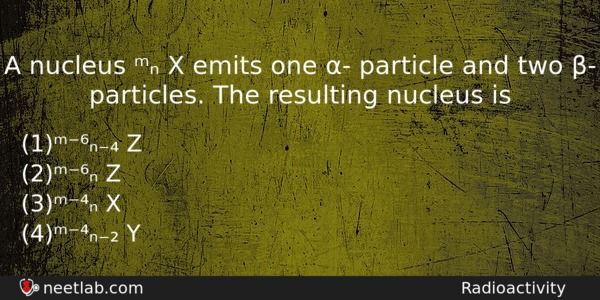| ⇦ | 
| ⇨ |
A nucleus ᵐₙ X emits one α- particle and two β- particles. The resulting nucleus is
Options
(a) ᵐ⁻⁶ₙ₋₄ Z
(b) ᵐ⁻⁶ₙ Z
(c) ᵐ⁻⁴ₙ X
(d) ᵐ⁻⁴ₙ₋₂ Y
Correct Answer:
ᵐ⁻⁴ₙ X
Explanation:
When ᵐₙ X emits one α- particle then its atomic mass decreases by 4 units and atomic number4 by 2. Therefore, the new nucleus becomes ᵐ⁻⁴ₙ₋₂ Y. But as it emits two β⁻ particles, its atomic number incre4ases by 2. Thus the resulting nucleus is ᵐ⁻⁴ₙ X.
Related Questions: - In which process, the P-V indicator diagram is a straight line parallel to volume
- In which of the following heat loss is primarily not due to convection?
- A charged particle (charge q) is moving in a circle of radius R with uniform speed v
- Sound waves travel at 350m/s through a warm air and at 3500 m/s through brass
- A common emitter amplifier is designed with n-p-n transistor (α=0.99).
Topics: Radioactivity
(83)
Subject: Physics
(2479)
Important MCQs Based on Medical Entrance Examinations To Improve Your NEET Score
- In which process, the P-V indicator diagram is a straight line parallel to volume
- In which of the following heat loss is primarily not due to convection?
- A charged particle (charge q) is moving in a circle of radius R with uniform speed v
- Sound waves travel at 350m/s through a warm air and at 3500 m/s through brass
- A common emitter amplifier is designed with n-p-n transistor (α=0.99).
Topics: Radioactivity (83)
Subject: Physics (2479)
Important MCQs Based on Medical Entrance Examinations To Improve Your NEET Score
18000+ students are using NEETLab to improve their score. What about you?
Solve Previous Year MCQs, Mock Tests, Topicwise Practice Tests, Identify Weak Topics, Formula Flash cards and much more is available in NEETLab Android App to improve your NEET score.
Share this page with your friends

Leave a Reply